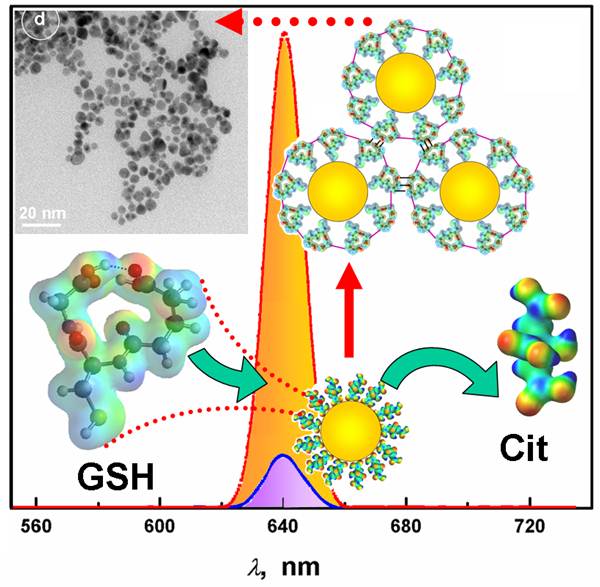3. Resonance Elastic Light Scattering (RELS) Spectroscopy of Fast Non-Langmuirian Ligand-Exchange in Glutathione-Induced Gold Nanoparticle Assembly
Publication: M. Stobiecka, K. Coopersmith, and M. Hepel, "Resonance Elastic Light Scattering (RELS) Spectroscopy of Fast Non-Langmuirian Ligand-Exchange in Glutathione-Induced Gold Nanoparticle Assembly", Journal of Colloid and Interface Science 350 (2010) 168-177.
The interactions of a biomolecule glutathione (GSH) with citrate-capped gold nanoparticles (AuNP) have been investigated to evaluate the viability of a rapid GSH-capture by gold nanoparticle carriers, as amodel system for applications ranging from designing nanoparticle-enhanced functional biosensor interfaces to nanomedicine. The measurements, performed using resonance elastic light scattering (RELS) spectroscopy, have shown a strong dependence of GSH-induced scattering cross-section on gold nanoparticle size. A large increase in RELS intensity after injection of GSH, in a short reaction time (s = 60 s), has been observed for small AuNP (5 nm dia.) and ascribed to the fast ligand-exchange followed by AuNP assembly. The unexpected non-Langmuirian concentration dependence of scattering intensity for AuNP5nm indicates on a 2D nucleation and growth mechanism of the ligand-exchange process. The ligand-exchange and small nanoparticle ensemble formation followed by relaxation have been observed in long term (10 h) monitoring of GSH–AuNP interactions by RELS. The results of molecular dynamics and quantum mechanical calculations corroborate the mechanism of the formation of hydrogen-bonded GSH-linkages and interparticle interactions and show that the assembly is driven by multiple H-bonding between GSH-capped AuNP and electrostatic zwitterionic interactions. The RELS spectroscopy has been found as a very sensitive tool for studying interparticle interactions. The application of RELS can be expanded to monitor reactivities and assembly of other monolayer-protected metal clusters, especially in very fast processes which cannot be followed by other techniques.

Graphical abstract
Sharp light scattering jumps have been observed for small (5 nm)
gold nanoparticles in a fast 60 s process of avalanche ligand-exchange and
glutathione-mediated nanoparticle assembly.